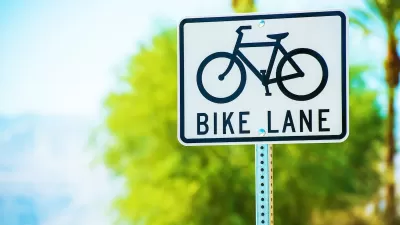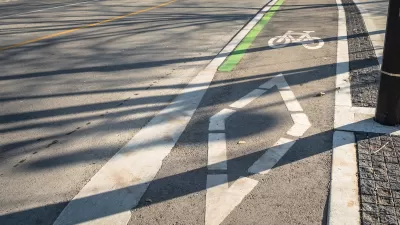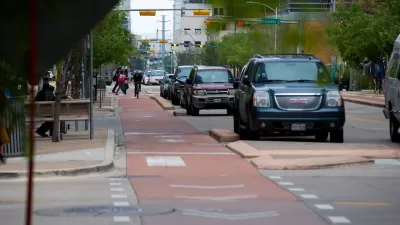With an 18-month pilot program coming to an end, local officials plan to dismantle the city’s only protected bike lane.

Editor's Note: After receiving a donation of $600,000 from the Sherwood Foundation on September 30, the bikeway will remain in place for roughly three years.
Omaha bike advocates are rallying to protest the removal of the city’s only protected bike lane, which the city plans to eliminate after the end of its pilot program despite support for the project from the City Council. As Jessica Wade reports for the Omaha World Herald, the protests were planned after Mayor Jean Stothert announced the decision not to extend the program.
“The city first opened the protected bike lane, known as the Market to Midtown Bikeway, in July 2021. The 2-mile, two-way lane is protected by bollards and set between the curb and parallel parking spaces,” Wade explains. An article by Arjav Rawal and Chris Bowling in The Reader points out that “In August, Bike Walk Nebraska released an evaluation of the bikeway that showed a 69% increase in the usage of bike share programs.”
Bike Walk Nebraska, an organization that lobbied for the bike lane, said it would cut ties with Metro Smart Cities, the advisory board co-chaired by Mayor Stothert that was convened to pilot innovative transit projects in the city.
According to the mayor, the city will evaluate the results of the project to inform future decisions about new bike infrastructure. The mayor also noted that the current Harney Street bike lane raises concerns because of a planned streetcar route that would run alongside the bike lane. Notably, according to the Reader article, “Jay Noddle, the president of the Omaha Streetcar Authority, said he didn’t want the streetcar to replace the Bikeway.”
FULL STORY: Events planned to protest removal of Omaha's protected bike lane

Alabama: Trump Terminates Settlements for Black Communities Harmed By Raw Sewage
Trump deemed the landmark civil rights agreement “illegal DEI and environmental justice policy.”

Planetizen Federal Action Tracker
A weekly monitor of how Trump’s orders and actions are impacting planners and planning in America.

The 120 Year Old Tiny Home Villages That Sheltered San Francisco’s Earthquake Refugees
More than a century ago, San Francisco mobilized to house thousands of residents displaced by the 1906 earthquake. Could their strategy offer a model for the present?

In Both Crashes and Crime, Public Transportation is Far Safer than Driving
Contrary to popular assumptions, public transportation has far lower crash and crime rates than automobile travel. For safer communities, improve and encourage transit travel.

Report: Zoning Reforms Should Complement Nashville’s Ambitious Transit Plan
Without reform, restrictive zoning codes will limit the impact of the city’s planned transit expansion and could exclude some of the residents who depend on transit the most.

Judge Orders Release of Frozen IRA, IIJA Funding
The decision is a victory for environmental groups who charged that freezing funds for critical infrastructure and disaster response programs caused “real and irreparable harm” to communities.
Urban Design for Planners 1: Software Tools
This six-course series explores essential urban design concepts using open source software and equips planners with the tools they need to participate fully in the urban design process.
Planning for Universal Design
Learn the tools for implementing Universal Design in planning regulations.
Clanton & Associates, Inc.
Jessamine County Fiscal Court
Institute for Housing and Urban Development Studies (IHS)
City of Grandview
Harvard GSD Executive Education
Toledo-Lucas County Plan Commissions
Salt Lake City
NYU Wagner Graduate School of Public Service





























